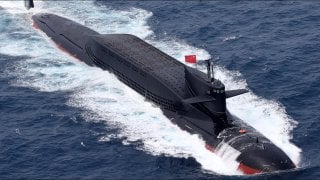Aircraft Carriers, Submarines and More: China's Navy Is a Real Powerhouse
Historically not much of a maritime power, today the Chinese Navy is counted as the pacing threat against which the U.S. and other Western Navies measure themselves.
Summary: This analysis examines the significant transformation of China from a historically continental-focused military to a major maritime power. Once not considered a significant naval force, the PLAN has, over the past two decades, rapidly expanded in both size and capability, positioning itself as a credible peer-level threat to the U.S. and other Western navies.
PLAN’s 21st Century Rise”
Historically not much of a maritime power, today the Chinese Navy is counted as the pacing threat against which the U.S. and other Western Navies measure themselves.
In particular, the past 20 years have seen a rapid expansion in the size and capability of the People’s Liberation Army Navy (PLAN).
The overall number and type of ships and the missions they embark on suggest the PLAN poses a credible peer-level threat in any potential conflict.
Chinese Navy History
Most of China’s military history has been focused on continental conflicts against aggressive neighbors or fending off seaborne invasions.
Rarely has the national conscience considered a navy as anything more than a roadblock against those attacking from the sea. Beginning in the 1980’s, however, perceptions began to shift as the PLAN sought to modernize and become a real player in the 21st century.
Technology sales from the U.S. and other Western nations aided in development of modern naval systems while leadership began more heavily emphasizing the need for a capable Navy.
Chinese Presidents from Deng Xiaoping in the ‘80s through Hu Jintao in the early 2000’s up until Xi Jinping at present have all made statements to various degrees in support of naval buildup. Beyond this, the state apparatus has clearly delivered on these ambitions.
More Ships
Centralized state control means production capacity can be placed where it is needed when it is needed and the PLAN has taken full advantage of this. In the early 2000’s, the PLAN consisted of around 220 ships.
In 2022, they surpassed the U.S. and now have upwards of 350 deployable ships to the U.S. Navy’s 296.
This growth in production has been astonishing, China has consistently commissioned more than 20 ships yearly, a rate German Vice-Admiral Schonbachsaid compares to “increasing the size of its navy by the equivalent of the entire French navy every four years.”
While this is truly a massive number of ships globally, it is important to note that this does not necessarily correlate directly to blue water capabilities. Many of these vessels are Type 056 Corvettes which are primarily designed for littoral operations.
China has increased its long-range operational capability as well with the commissioning of Liaoning - a partially completed Kuznetsov-class carrier purchased from Ukraine in the late 1990s - in 2016, which was followed up by the construction of the Shandong, a homegrown carrier.
These mark the first entries into carrier naval aviation for the PLAN, and they will undoubtedly need time to become proficient at carrier operations; however, they are an important step forward in making the PLAN a peer competitor of Western nations.
More Capabilities:
In addition to fielding more ships, China is fielding more capable vessels. In 1996, only three of China’s 57 destroyers and frigates had anti-air capabilities, and most of its attack submarines were based on Soviet designs from the 1950s. Between 2010 and 2017 RAND ranked China’s ships as improving from only 50% to over 70% being considered modern.
In the past few decades, the PLAN has added fleet replenishment ships, an amphibious assault ship, and a hospital ship to their inventory. They demonstrated a limited ability to conduct deployed operations 2009 when they sent several task groups with supporting oilers to the Gulf of Aden to participate in anti-piracy missions.

Other technological advancements include strides in anti-ship missiles, both cruise and ballistic. Such weapons are tailor made for anti-access/area denial of U.S. forces in the South China Sea and Strait of Taiwan, two likely flash points of future conflict.
About the Author: Maya Carlin
Maya Carlin, National Security Writer with The National Interest, is an analyst with the Center for Security Policy and a former Anna Sobol Levy Fellow at IDC Herzliya in Israel. She has by-lines in many publications, including The National Interest, Jerusalem Post, and Times of Israel. You can follow her on Twitter: @MayaCarlin.


